1997 OLDSMOBILE BRAVADA ESP
[x] Cancel search: ESPPage 144 of 358
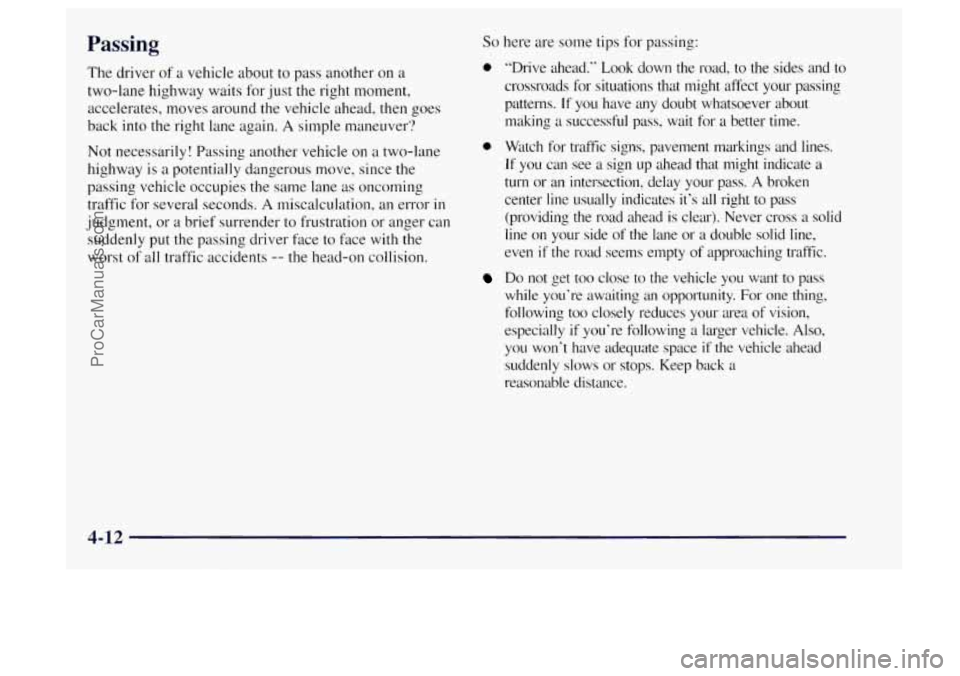
So here are some tips for passing: Passing
The driver of a vehicle about to pass another on a
two-lane highway waits for just
the right moment,
accelerates, moves around the vehicle ahead, then goes
back into the right lane again.
A simple maneuver‘?
Not necessarily! Passing another vehicle on a two-lane
highway is
a potentially dangerous move, since the
passing vehicle occupies the same lane as oncoming
traffic for several seconds.
A miscalculation, an error in
judgment, or a brief surrender to frustration or anger can
suddenly put the passing driver face to face with
the
worst of all traffic accidents -- the head-on collision.
0 “Drive ahead.” Look down the road, to the sides and to
crossroads for situations that night affect your passing
patterns.
If you have any doubt whatsoever about
making
a successful pass, wait for a better time.
0 Watch for traffic signs, pavement markings and lines.
If you can see a sign up ahead that might indicate a
turn or an intersection, delay your pass. A broken
center line usually indicates it’s all right to pass
(providing the road ahead
is clear). Never cross a solid
line on your side of the lane or
a double solid line,
even
if the road seems empty of approaching traffic.
Do not get too close to the vehicle you want to pass
while you’re awaiting an
opportunity. For one thing,
following too closely reduces your area of vision,
especially
if you’re following a larger vehicle. Also,
you won‘t have adequate space
if the vehicle ahead
suddenly
slows or stops. Keep back a
reasonable distance.
4-12
ProCarManuals.com
Page 146 of 358

Loss of Control
Let’s review what driving experts say about what
happens when
the three control systems (brakes, steering
and acceleration) don’t have enough friction where the
tires meet the road to do what the driver has asked.
In any emergency, don’t give up. Keep trying to steer and
constantly seek an escape route or area of less danger.
Skidding
In a skid, a driver can lose control of the vehicle.
Defensive drivers avoid most skids by taking reasonable
care suited
to existing conditions, and by not “overdriving”
those conditions. But skids are always possible.
The three types of skids correspond to your
Oldsmobile’s three control systems. In the braking skid,
your wheels aren’t rolling.
In the steering or cornering
skid, too much speed or steering in a curve causes tires
to slip and lose cornering force. And
in the acceleration
skid, too much throttle causes the driving wheels
to spin.
A cornering skid and an acceleration skid are best
handled by easing your foot off the accelerator pedal.
If your vehicle starts to slide, ease your foot off the
accelerator pedal and quickly steer the way you want the
vehicle to go. If you start steering quickly enough, your
vehicle may straighten out. Always be ready for
a
second skid if it occurs.
Of course, traction
is reduced when water, snow, ice,
gravel or other material is on the road. For safety, you’ll
want
to slow down and adjust your driving to these
conditions.
It is important to slow down on slippery
surfaces because stopping distance will be longer and
vehicle control more limited.
While driving on a surface with reduced traction, try
your best to avoid sudden steering, acceleration or
braking (including engine braking by shifting to a lower
gear).
Any sudden changes could cause the tires to slide.
You may not realize
the surface is slippery until your
vehicle is skidding. Learn to recognize warning
clues
-- such as enough water, ice or packed snow on
the road to make a “mirrored surface” -- and slow
down
when you have any doubt.
Remember:
Any anti-lock brake system (ABS) helps
avoid only the braking skid.
4-14
ProCarManuals.com
Page 147 of 358
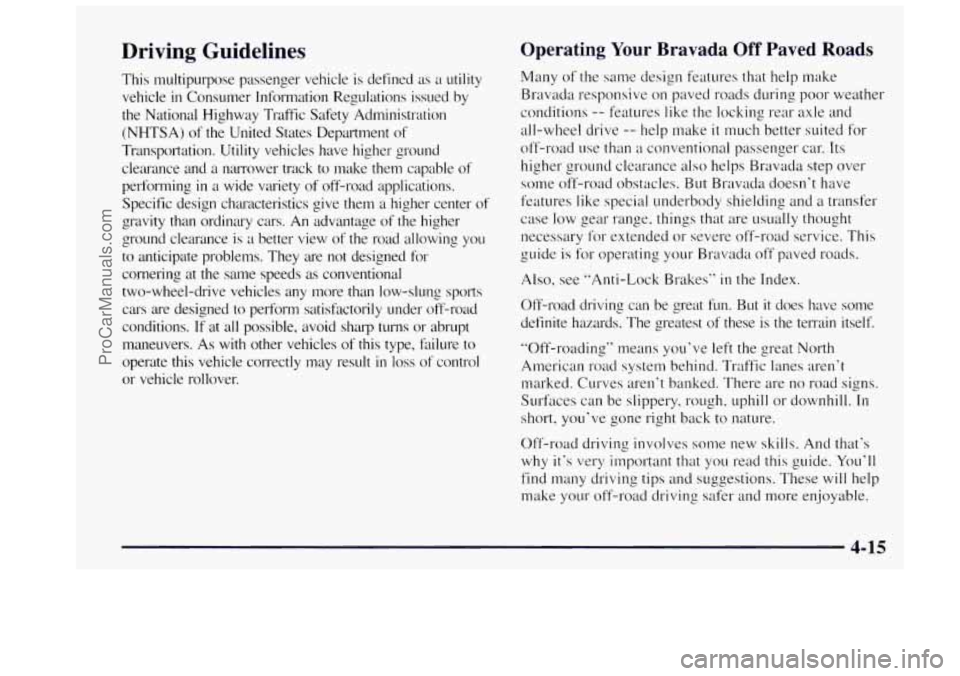
Driving Guidelines
This multiplrpose passenger vehicle is defined as a utility
vehicle in Consumer Information Regulations issued by
the National Highway Traffic Safety Administration
(NHTSA) of the United States Department of
Transportation.
Utility vehicles have higher ground
clearance and a narrower track to make them capable
of
performing in a wide variety of off-road applications.
Specific design characteristics give them a higher center of
gravity than ordinary cars.
An advantage of the higher
ground clearance is
a better view of the road allowing you
to anticipate problems. They are not designed
for
cornering at the same speeds as conventional
two-wheel-drive vehicles any more than low-slung sports
cars are designed to perform satisfactorily under off-road
conditions.
If at all possible, avoid sharp turns or abrupt
maneuvers.
As with other vehicles of this type, failure to
operate this vehicle correctly may result
in loss of control
or vehicle rollover.
Operating Your Bravada Off Paved Roads
Many of the same design features that help make
Bravada responsive on paved roads during poor weather
conditions
-- features like the locking rear axle and
all-wheel drive
-- help make it much better suited for
off-road use than
a conventional passenger car. Its
higher ground clearance also helps Bravada step over
some off-road obstacles.
But Bravada doesn’t have
features like special underbody shielding and a transfer
case low gear range. things that are
LISLI~~~Y thought
necessary for extended or severe off-road service. This
guide is for operating your Bravada off paved roads.
Also, see “Anti-Lock Brakes’’
in the Index.
Off-road driving can be great fun.
But it does have some
definite hazards. The greatest
of these is the terrain itself.
“Off-roading” means you’ve left the great North
American
road system behind. Traffic lanes aren’t
marked. Curves aren’t banked. There are
no road signs.
Surfaces can
be slippery, rough, uphill or downhill. In
short, you’ve gone right back to nature.
Off-road driving involves some new skills. And that’s
why it’s very important that you read this guide. You’ll
find many driving tips and suggestions. These will help
make your off-road driving safer and more enjoyable.
ProCarManuals.com
Page 149 of 358
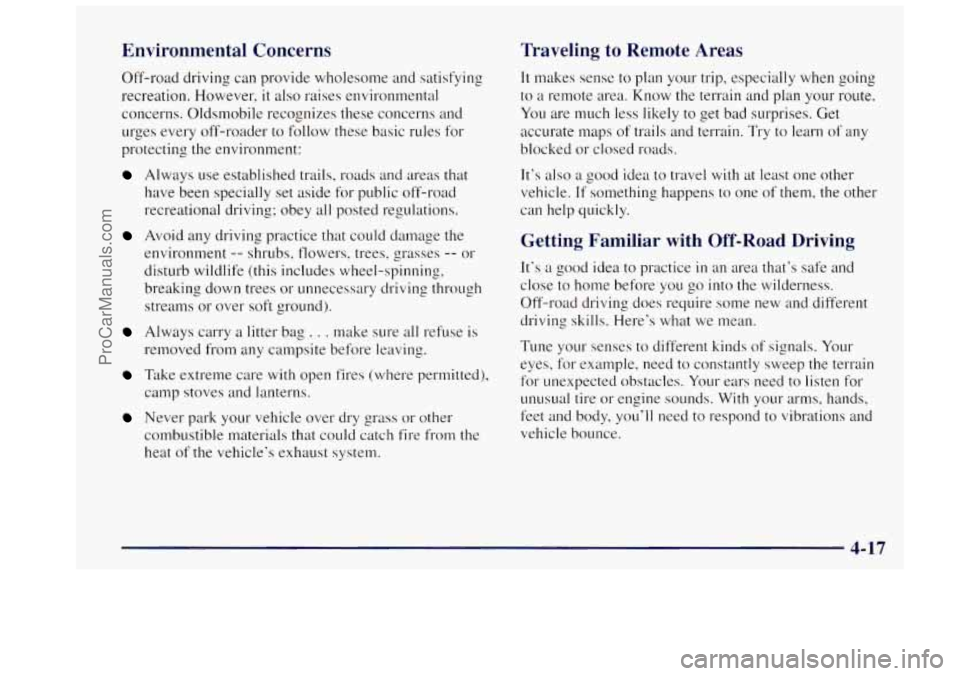
Environmental Concerns
Off-road driving can provide wholesome and satisfying
recreation. However, it also raises environmental
concerns. Oldsmobile recognizes these concerns and
urges every off-roader to follow these basic rules for
protecting the environment:
Always use established trails, roads and areas that
have been specially set aside for public off-road
recreational driving; obey all posted regulations.
Avoid any driving practice that could damage the
environment
-- shrubs, flowers, trees, grasses -- or
disturb wildlife (this includes wheel-spinning,
breaking down trees or unnecessary driving through
streams or over soft ground).
Always carry a litter bag . . . make sure all refuse is
removed from any campsite before leaving.
Take extreme care with open fires (where permitted),
camp stoves and lanterns.
Never park your vehicle over dry grass or other
combustible materials that could catch fire from the
heat of the vehicle’s exhaust system.
Traveling to Remote Areas
It makes sense to plan your trip, especially when going
to a remote area. Know the terrain and plan your route.
You are much less likely to get bad surprises. Get
accurate maps of trails and terrain. Try to learn of any
blocked or closed roads.
It’s
also a good idea to travel with at least one other
vehicle.
If something happens to one of them, the other
can help quickly.
Getting Familiar with OY oad Driving
It’s a good idea to practice in an area that’s safe and
close to home before
you go into the wilderness.
Off-road driving does require some new and different
driving skills. Here’s what we mean.
Tune your senses to different kinds of signals. Your
eyes, for example, need to constantly sweep the terrain
for unexpected obstacles. Your ears need to listen for
unusual tire or engine sounds. With your arms, hands,
feet and body, you’ll need to respond to vibrations and
vehicle bounce.
4-17
ProCarManuals.com
Page 150 of 358

Cont.rolling your vehicle is the key to successful
off-road driving. One
of the best ways to control your
vehicle is to control your speed. Here are some things to
keep
in mind. At higher speeds:
0 you approach things faster and you have less time to
scan the terrain for obstacles.
0 you have less time t.o react.
0 you have more vehicle bounce when you drive
over obstacles.
0 you‘ll need more distance for braking, especially
since you’re on an unpaved surface.
When you’re driving off-road, bouncing and
quick changes in direction can easily throw you
out of position. This could cause you to lose
control and crash.
So, whether you’re driving on
or off the road, you and your passengers should
wear safety be1t.s.
Scanning the Terrain
Off-road driving can take you over many different kinds
of terrain.
You need to be familiar with the terrain and
its many different features. Here are some things
to consider.
Slrrjji~~~ Cn1~tlitio~7.s. Off-roading can take you over
hard-packed
dirt, gravel, rocks, grass, sand, mud, snow
or ice. Each of these surfaces affects the steering,
acceleration and braking
of your vehicle in different
ways. Depending upon the kind of surface you are on,
you may experience slipping, sliding, wheel spinning,
delayed acceleration, poor traction and longer
braking distances.
Su~jircc. O6st~trcI~.s.. Unseen or hidden obstacles can be
hazardous. A rock,
log, hole, rut or bump can startle you if
you’re not prepared for them. Often these obstacles are
hidden by
grass, bushes, snow or even the rise and fall of
the terrain itself-’. Here are some things to consider:
0 Is the path ahead clear?
0 Will the surface texture change abruptly up ahead?
0 Does the travel take you uphill or downhill? (There’s
more discussion
of these subjects later.)
Will you have to stop suddenly or change
direction quickly?
ProCarManuals.com
Page 151 of 358
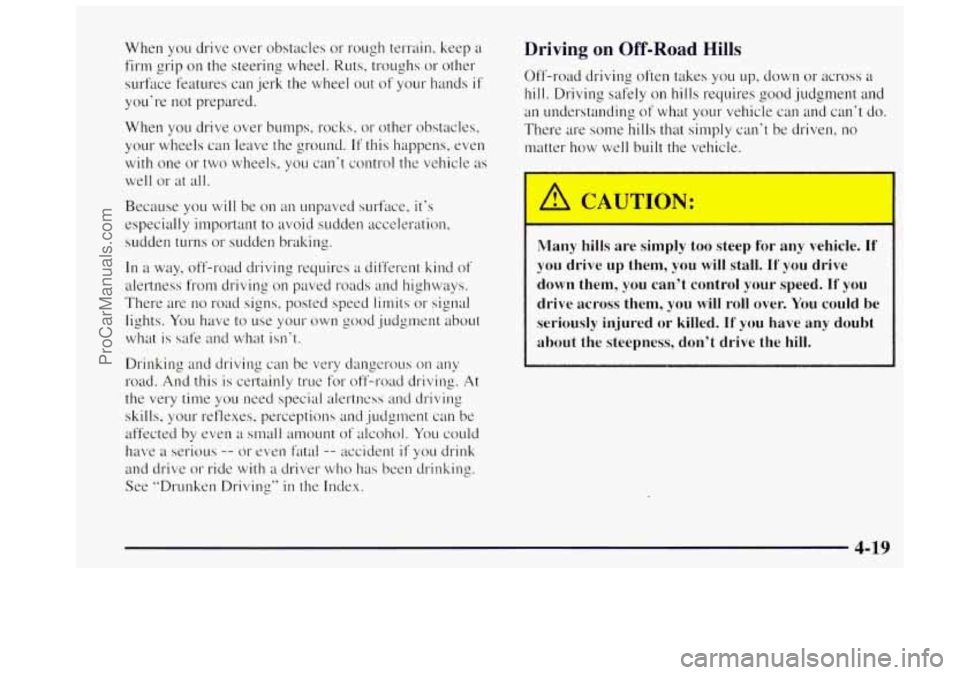
When YOLI drive over obstacles or rough terrain, keep a
firm grip on the steering wheel. Ruts, troughs or other
surface features can jerk the wheel out of your hands if’
you’re not prepared.
When you drive over bumps, rocks, or other obstacles,
your wheels can leave the ground.
If this happens, even
with one or two wheels, you can’t control the vehicle as
well or at
all.
Because you will be on an unpaved surface, it’s
especially important
to avoid sudden acceleration,
sudden turns or sudden braking.
In a way, off-road driving requires a different kind of
alertness from driving on paved roads and highways.
There are
no road signs, posted speed limits or signal
lights.
You have to use your own good judgment about
what is safe and what isn‘t.
Drinking and driving can be very dangerous
on any
road. And this
is certainly true for off-road driving. At
the very time you need special alertness and driving
skills, your reflexes, perceptions and judgment can be
affected by even a small amount of alcohol.
YOLI coulcl
have a serious -- or even fatal -- accident if you drink
and drive or ride
with a driver who has been drinking.
See ”Drunken Driving”
in the Index.
Driving on Off-Road Hills
Off-road driving often takes you up, down or across a
hill. Driving safely on hills requires good judgment and
an understanding of what your vehicle can and can’t do.
There are some hills that simply can’t be driven, no
matter how well built the vehicle.
I PL CAUTION:
Many hills are simply too steep for any vehicle. If
you drive up them, you will stall. If you drive
down them, you can’t control your speed. ]If you
drive across them,
you will roll over. You could be
seriously injured or killed.
If you have any doubt
about the steepness, don’t drive the hill.
4-19
~
ProCarManuals.com
Page 160 of 358

Driving at Night Here are some tips on night driving.
0
0
0
0
0
0
0
Drive defensively.
Don’t drink and drive.
Adjust your inside rearview mirror to reduce the
glare from headlamps behind you.
Since you can’t see as well, you may need to slow
down and keep more space between you and
other vehicles.
Slow down, especially on higher speed roads. Your
headlamps can light up only
so much road ahead.
In remote areas, watch for animals.
If you’re tired, pull off the road in a safe place
and rest.
Night driving is more dangerous than day driving.
One reason is that some drivers are likely
to be
impaired
-- by alcohol or drbgs, with night vision
problems, or by fatigue.
4-28
ProCarManuals.com
Page 164 of 358
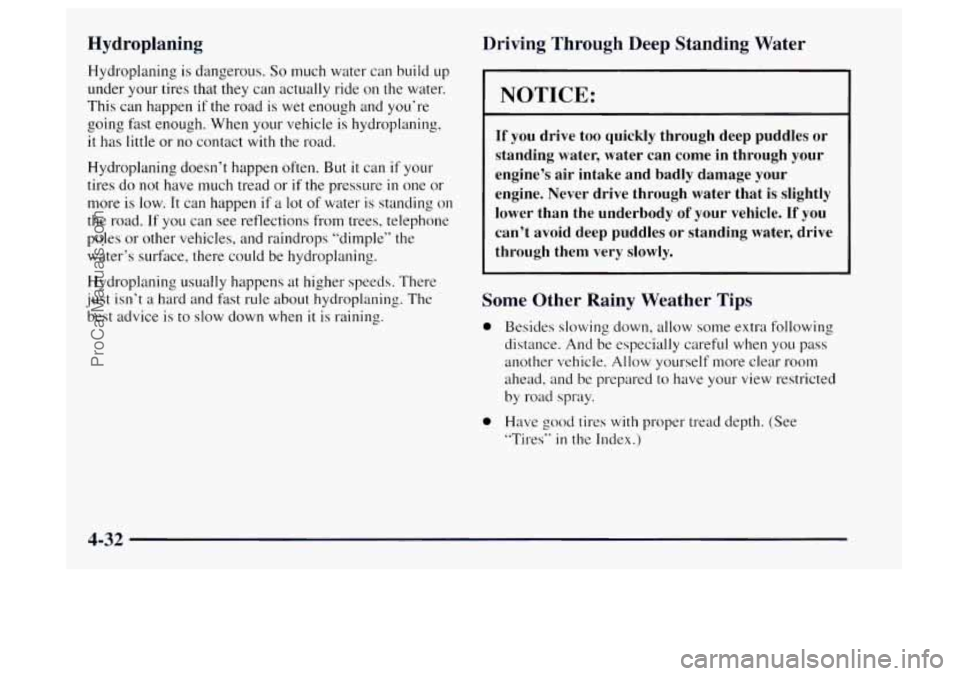
Hydroplaning
Hydroplaning is dangerous. So much water can build up
under your tires that they can actually ride on the water.
This can happen
if the road is wet enough and you’re
going fast enough. When your vehicle is hydroplaning,
it has little or no contact
with the road.
Hydroplaning doesn’t happen often.
But it can if your
tires do not have much tread or
if the pressure in one or
more is low. It can happen if
a lot of water is standing on
the road.
If you can see reflections from trees, telephone
poles or other vehicles, and raindrops “dimple” the
water’s surface, there could be hydroplaning.
Hydroplaning usually happens at higher speeds. There
just isn’t a hard and fast rule about hydroplaning. The
best advice is to slow down when
it is raining.
Driving Through Deep Standing Water
NOTICE:
If you drive too quickly through deep puddles or
standing water, water can come in through your
engine’s air intake and badly damage your
engine. Never drive through water that is slightly
lower than the underbody
of your vehicle. If you
can’t avoid deep puddles or standing water, drive
through them very slowly.
Some Other Rainy Weather Tips
0 Besides slowing down, allow some extra following
distance. And be especially careful when you pass
another vehicle. Allow yourself more clear room
ahead, and
be prepared to have your view restricted
by road spray.
0 Have good tires with proper tread depth. (See
“Tires“
in the Index.)
4-32
ProCarManuals.com